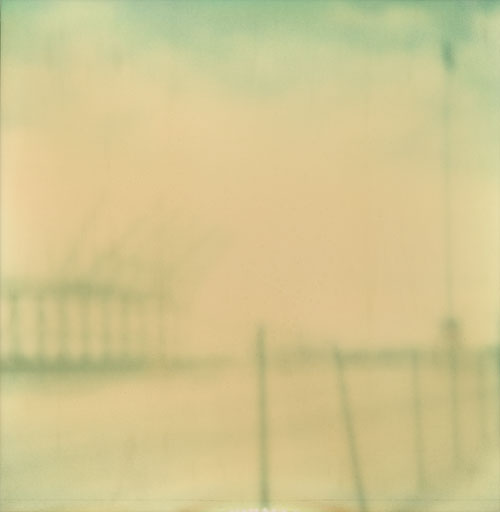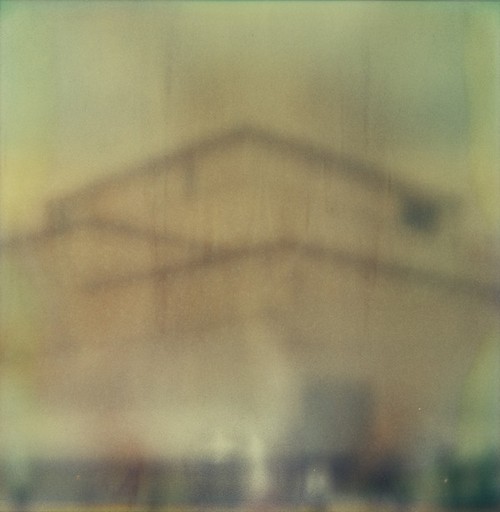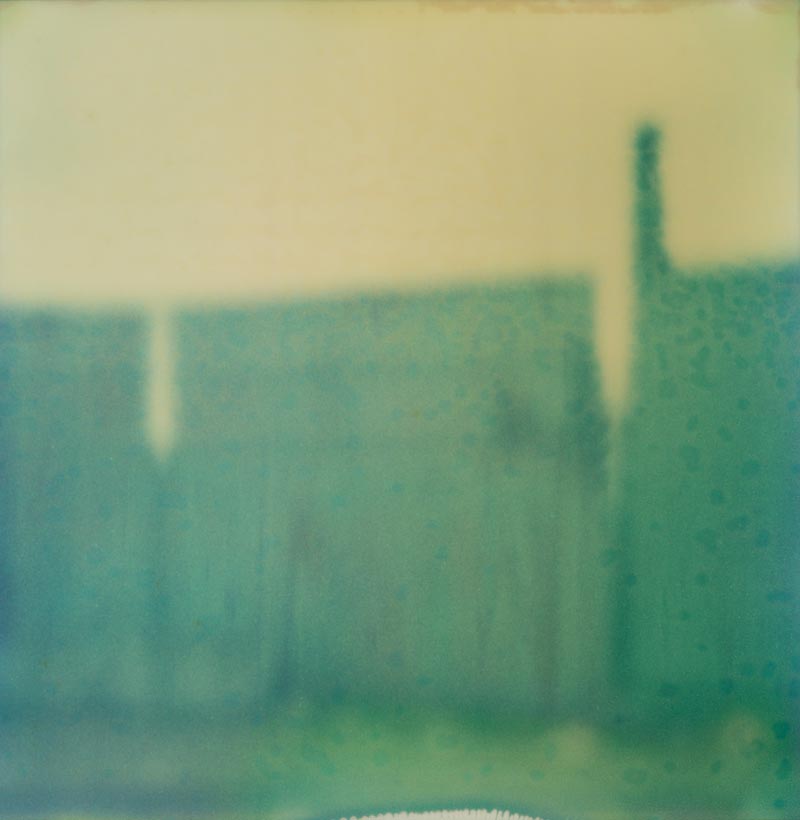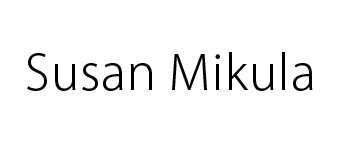Getting the News: Susan Mikula’s American Bond
George Lawson
It is difficult to get the news from poems
yet men die miserably every day for lack
of what is found there.
—William Carlos Williams, from Asphodel, That Greeny Flower

American Device #31
In 2009 Susan Mikula traveled to Louisiana and Texas and then on to California with close friend and volunteer driver Jill McDonough to take a series of Polaroid photographs of industrial dock sites, using an SX-70 Alpha 1 camera that by then qualified as an antique. She had to procure the packets of self-developing film, long commercially unavailable, on eBay, through garage sales, or wherever she could find them. In some cases the film had been sitting around on people’s dusty garage shelves for decades. The red spectrum of the dyes had faded and the surface emulsions had coagulated, leaving her with a characteristic greenish palette and fractured surface that she learned to exploit. Her choice to shoot in Polaroid may have initially been driven by aesthetics, but as the series has unfolded into a cycle of almost 60 finished images that span three years, it has become apparent just how commensurate are her chosen medium and her chosen subject. Mikula has captured a fading aspect of a bygone era with fading film and an obsolete technology.

American Vale #17
Mikula shot the cycle with a soft focus intentionally gauged with the adjustable lens or auto-focus override of her camera. Her methods of shooting ostensibly out of focus and occasionally overlaying multiple images allowed her to push the film to accept more light—that is, more information—by intentionally long exposures. The result feels like memory, but she ducks nostalgia because she avoids interpretive journalism in her treatment and because, despite the anachronism of Polaroid, she incorporates the most contemporary of means into her overall process. She digitally scans her original Polaroids, adjusts the scale and then puts them out as pigment prints (technically similar to ink jet but with archival pigments) on rag paper, mounts these in turn onto back-framed aluminum, and sprays the final surface with a matte varnish. The image itself is true to the camera shot, and is not digitally post-produced, other than to grow physically larger and to lose the glossy sheen of the original Polaroid. American painter Jasper Johns is often quoted as having said that to make art, you take something and do something to it, then do something to that, then do something to that. Mikula fits the axiom. The fruit of this series of operations, although still technically a photograph, is strangely concrete, as satisfying an object as it is an image, and extends the inherent commensurability of her method and her motif, producing a post-industrial artifact with a hand finish and a history of its own.
Following her initial foray into the ports of Galveston, Texas and Long Beach, California, Mikula gathered the best of the images under the title, American Device, and then took a second trip, this time inland to Pittsfield, Massachusetts, to shoot the factories and warehouses of companies such as General Electric and Raytheon. By now she knew she was working on a greater cycle, later to be collectively titled American Bond, and this second leg of the suite she called, American Vale. We showed selections from American Device in the San Francisco gallery in February of 2010 and selections from American Vale in March of 2011. We present chosen works from the third series in the cycle, American Breakbulk, in the Los Angeles gallery concurrent with the release of this book. The term “Breakbulk” refers to cargo that has been separated from its container on the docks for handling, and perhaps there is something of a summation in the reference, as we can now take each image in the expanded cycle and view it both individually and in context to the whole achievement. And Mikula’s achievement with the American Bond cycle is significant.
Formally, as a photographer here in our gallery stable dominated by very tactile painters, she more than holds her own as a concrete artist, someone who makes things that have body. Socially, her content, the narrative of her work, is as current as this morning’s AP wires, though she brings a Zen-like equanimity to the volatile issue of the country’s waning industrial strength. She declines to blame or editorialize; still she doesn’t eschew the impact or the sobering ramifications of her subject. For all that, these images are beautiful; although some of the facilities she photographed have since been demolished, Mikula manages to filter a sense of phoenix-like resurrection through her documentation.

American Breakbulk #10
Perhaps resiliency would be a better word, for as President Obama named it in a speech of just a few weeks ago, resilience is the American bond. Whatever sinew will see us through the stresses inferred in every image in Mikula’s cycle, it boils down to just hanging in there. For artists who struggle with the balance between a universal, perennially relevant form to their art and the immediate impact of social engagement, that resilience serves as much to preserve and contextualize our collective past as to provide a shared conscience for our ever-unfolding present. To these ends, Susan Mikula’s art is one part interpretive and nine parts generative. She understands history but she is making news.
George Lawson
Los Angeles, September 2011
George Lawson is the owner and director
of the George Lawson Gallery.
